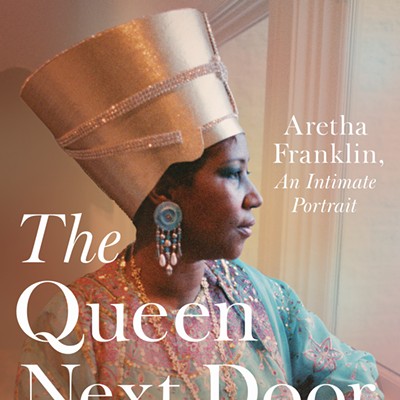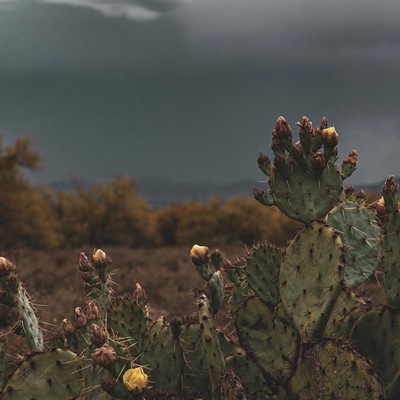"We are here to honor one of our own," said the artist Andy Rush, head of The Drawing Studio, which has just opened a fundraising exhibition to drum up cash for a whole cluster of projects that will bring Bernal's photography to the public after a long absence. Added Frank Pickard, dean of arts at Pima College, "I did not know Lou Bernal ... but his spirit is alive in this room. If it had not been for his spirit, his drive, his vision, I would not be here today."
Isabel tossed her head at these fine words, and Bernal might have approved of the rebel spirit in this tiny descendant he never knew. Friends say Bernal, charming, intense, exacting, talented, would be bemused by the hagiography that has followed his tragic death. A famously supportive teacher and mentor, Bernal is credited with developing Pima's respected photography program; as an artist he is best known for his telling portraits of Southwest barrio life. But while bicycling to work at Pima's West Campus on an October morning in 1989, the photographer was struck by a car. He lingered almost four years in a coma until he died on his 52nd birthday in 1993.
The lengthy, devastating illness quickly drained his family's finances, said Ann Simmons-Myers, the photographer and friend who succeeded him in the job at Pima, believing at first the job would be only temporary. Now Simmons-Myers is leading the effort to get Bernal's work back in circulation. But cash is a problem.
"We need money," Simmons-Myers said frankly, taking a few moments away from the opening festivities of the Bouquet for Lou Bernal exhibition. Pima College has at long last agreed to name its art gallery for Bernal, and Simmons-Myers is curating a major Bernal retrospective whose opening Nov. 2 will coincide with the dedication. (Bernal's daughters, Lisa Bernal Brethour, Isabel's mother, and Katrina Bernal chose the date, All Souls' Day, for its resonance in Mexican-American culture.) An accompanying scholarly book will feature dozens of images, and essays by such luminaries as author Leslie Marmon Silko and artist Luis Jimenez, both friends of Bernal, and James Enyeart, the respected photography expert who was the first director of the Center for Creative Photography. A video is also in the works; and future proceeds will go toward a Bernal scholarship at Pima.
None of these projects come cheap--the total tab is about $60,000. At least one expected grant has fallen through, and All Souls' Day is looming.
"We don't have a lot of corporate support," Simmons-Myers said. "We've got about $30,000--we're about halfway there."
Organizers are hoping that the exhibition at the Drawing Studio will raise a big chunk of that cash. Some 80 artists, many of them friends and former students of the photographer, contributed works to be sold via a silent auction; closing date for bids is Aug. 10. Curated by local photographer Alan Huerta, the show is less a bouquet and more a garden of works in nearly every medium, from photography to painting to glass to wood and ceramic. Jimenez, probably the best-known Chicano artist working today, contributed editions of two different black-and-white lithographs, made in 1992 while he was grieving for his comatose friend. One of them, "Comprades," pictures the slumping Bernal in the compassionate arms of a real-life Bernal subject, a man whose Virgin of Guadalupe tattoo was immortalized in a famous Bernal photograph.
Jim Waid offered a loose and lovely watercolor, Judith D'Agostino a large painted landscape, and Tom Philabaum a glistening yellow glass vase. Among the photographers are Simmons-Myers, checking in with one her elegant shrouded figures, this one lying in cool gray sand, and Stu Jenks, with a nice nighttime picture of the old Pima County Courthouse. There's even one authentic Bernal, donated anonymously, a color picture of a household shrine, its pink flowers draping an image of the suffering Christ.
Bernal photographed other subjects, including the Los Angeles Olympics of 1984, but for the show and book, "I concentrated on the barrio work," Simmons-Myers said. "It's the most important. His portraits and interiors are very powerful. He liked getting close to people."
Everybody, says Jerre Johnson, has a Lou story.
"One day I ran into him and we got to talking," says Johnson, the publicist at Etherton Gallery and an adjunct professor in art history at Pima Community College. "He asked me questions, intently, for 45 minutes. It was so nice, and so unusual. I was flattered by his interest. Then suddenly he said, 'How would you like to teach the history of photography?'"
Johnson was flabbergasted. She had never taught before but Bernal somehow had divined exactly what she wanted to do and, moreover, intuited that she'd be good at it. Bernal hired Johnson practically on the spot. This was in 1989, and Johnson's been teaching at the college ever since.
"He was a great guy," she said.
Such tales are legion, said Lisa Bernal Brethour, who also benefited from her father's unusual capacity for insight. Brethour was a 20-year-old engineering student at the University of Arizona in 1989 when her father was struck. Uncannily, the night before the accident, she said, "I had a similar conversation with him. He questioned me closely about what I wanted to do with my life."
His friend Waid, who taught with him at Pima in the '70s, remembered Bernal's delight when he finally discovered his best and most enduring subjects, the barbershops and chollas and quinceaneras of the barrio. Best of all are his haunting house interiors, the home altar of an elderly woman captured in ethereal black-and-white in "Benetiz Suite," the pungently colored pink walls in a young Latina's bedroom.
"When he started going into people's homes, he'd come back and say, 'Jim, you wouldn't believe what's in these houses ... You could see him grow. He'd come back bubbling with energy. He knew when the old folks went, the young people weren't going to be doing that anymore."
As a teacher, Bernal "was interesting and funny," Waid said, and impatient with trendy cant. "He never bought into this process-over-product stuff. He'd say, 'If you've got a good product, that means the process was good.' ... He was very good teacher, an incredible teacher."
And he's teaching still. Michael Gonzales, an MFA student at the UA, contributed a photo to the Bouquet show, a witty black-and-white of cheerleaders on parade. He's gotten some attention in the media already for a documentary barrio project of his own: He's been photographing at Pat's on the West Side nearly every single day. A native Texan, Gonzales didn't know Bernal's work until his professors urged him so seek it out.
"His work really struck home for me," Gonzales said. "Lou might not need another one, but he has another student in me."














